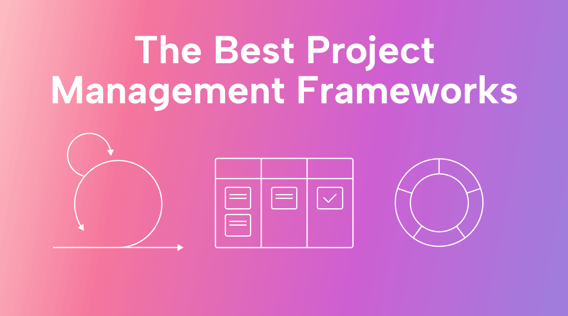When we build things, we start with the frame and then build outwards. Frames help support what you build. Simple, right?
Your chair uses a frame. A car is built around one, and buildings use them to support their weight.
A project management framework does exactly the same for projects. These ‘frames’ outline and guide you through the processes, tools, project activities, and planning needed for complex projects, from initiation (project scope) to delivery.
In this article, we'll look into project management frameworks, the key elements of using one, and a few top choices you can use for future projects.
What is a project management framework?
A project management framework is a collection of processes, templates, and tools that act as a guide to help plan, control, and deliver projects.
These frameworks outline the steps to keep your project on track and help you deliver successful project outcomes.
For example, Scrum is an Agile framework that uses short increments called sprints lasting 1–4 weeks. Iterating through the development (work, build) piece of a project like this can help you consistently deliver value while adapting to changes "on the fly."
There are different flavors of frameworks (Agile methodology and traditional approaches) to choose from depending on your project and experience. And even though the approaches may differ, they all provide a framework to support the entire project.
But first, let's talk about project management methodologies vs. frameworks.
Project management methodology vs framework
The difference between project management methodologies and frameworks can be confusing but easy enough to unravel.
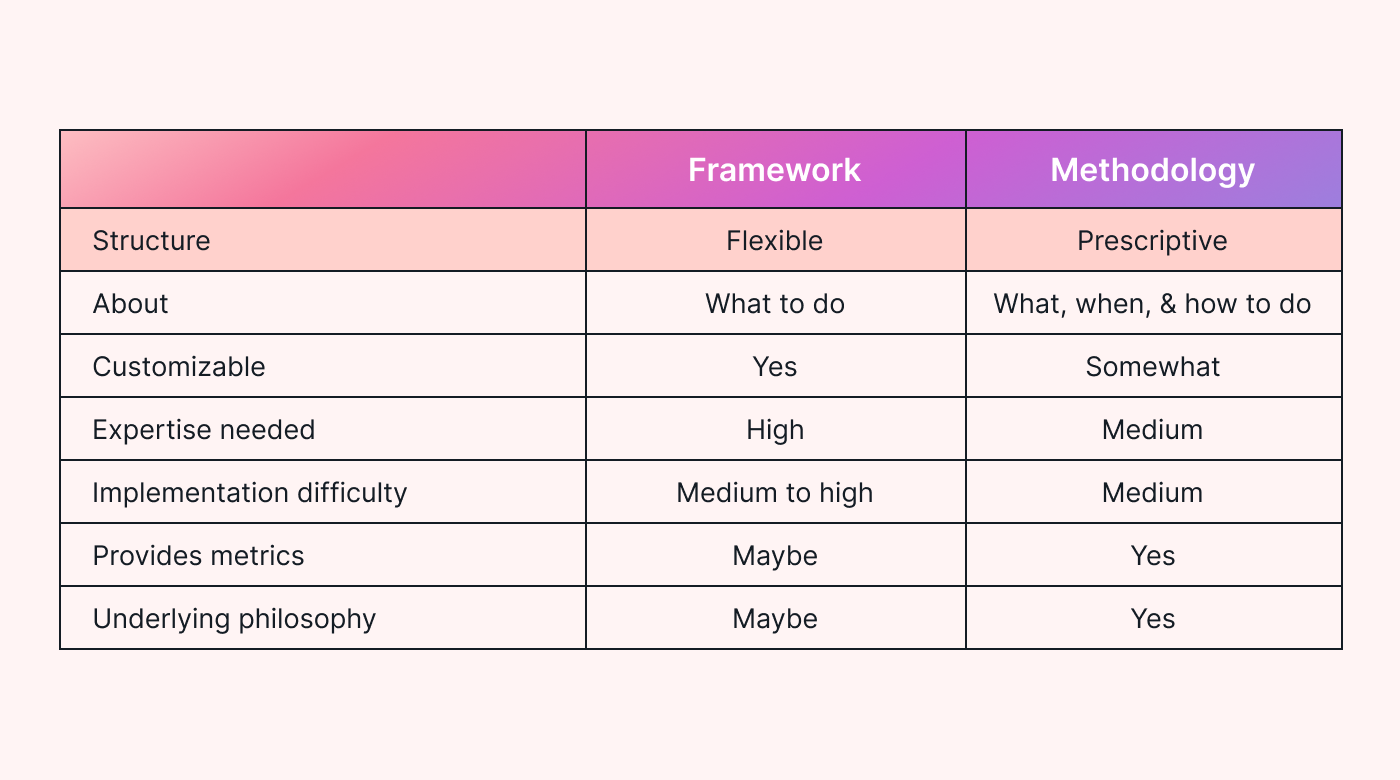 |
A project methodology is a set of key principles or processes supporting a project. Methodologies tend to be firmly set and have clear-cut phases, artifacts, and ceremonies that help prevent the project from going off track.
You have more leeway and autonomy within the boundaries of a framework. Adapt rules, adopt new ones mid-framework, and drop them as needed. In addition, a framework has much more specific information and detailed instructions. Some may include pieces not part of the methodology (e.g., complex team-building processes and mid-project assessments).
Think of it this way: say you want to build a new house. You'd first tell the architect what style of the house. Colonial, mid-century, or whatever your vibe is. That's the project management methodology. Then, after the project plan was hashed out based on the architectural renderings, the builder would lay the foundation and frame the house. That's the project management framework. That frame makes it much easier to, then, build out everything.
Why is a project management framework important?
A project management framework is critical for optimizing your team and resources, increasing the likelihood of achieving project objectives. Beyond that, it’s vital for these various reasons:
Efficiency
Most, if not all, project management professionals will tell you that managing a project successfully from start to finish is no walk in the (dark) park.
But, doing so with a framework can help you anticipate and define the necessary steps to take during the process. This can dramatically improve efficiency, like having a flashlight and signposts in that park.
Communication
Nothing can tank a project faster than poor communications (all around).
Project frameworks give you processes and a language around which to base communications.
Furthermore, most project management tools have built-in communication tools. Using these tools opens up the possibility of an ongoing exchange of information between the project team, stakeholders, and customers. More on that later.
Bonus points for the transparency that comes with better communications.
Track work
A central tenet of almost all project frameworks is to track and manage tasks once the work begins. After all, you want to ensure that your project framework pays dividends.
All project management frameworks include some artifacts, tools, or techniques to help you track work. Not only will you be better equipped to track work, but you can also better (and more quickly) identify inefficiencies and bottlenecks.
Finally, tracking the work also helps you calculate the time and money you’re burning. Not inconsequential matters.
The 3 main components of a project management framework
The three main components of a project management system are the processes, the artifacts produced (outputs and controls), and the tools. These help create a dependable, consistent approach to managing your projects.
These three elements aren't necessarily done in a particular sequence. However, when combined, they can help you run projects like clockwork.
Project processes
Not to get too confusing, but the project management framework, which is a collection of processes, is (also) your project lifecycle.
Each methodology’s project process (a.k.a. project phases) can differ vastly. For example, PRINCE2 uses seven phases, Agile methodology uses six, and the waterfall methodology uses four to five. However, they have a few common phases across the board, including planning and development (work, build).
Project artifacts
Artifacts are things that you produce during the project. Think of historical artifacts: they aren't history itself, but something physical that was produced during whatever period of history (think King Tut's death mask).
Most artifacts conform to a standard. Some artifacts help you control the execution of a project. Here are two examples:
Product backlog
The product backlog is a primary artifact of Scrum. It's basically a to-do list on steroids (from the user's point of view).
Before every sprint, your team will come together with stakeholders to rank the most important user stories (to-do items) and add them to their sprint backlog, which is the work plan for the next sprint.
Work breakdown structure (WBS)
If you adopt a traditional project management method, the WBS will be one of the main deliverables. A WBS is a tool for dividing the major project goals of a project into smaller, actionable tasks.
For example, if you’re producing a new app (the project goal at the top of the WBS), detailed tasks like testing and releasing the app might be at the bottom of what looks like a Christmas tree (without a stump).
Project tools and templates
A framework may suggest particular tools that can help you gauge your project’s present or future condition. Every project management methodology and framework has its own tools and templates.
Let’s take a look at five of the more popular tools:
- A Gantt chart is a graphical representation of a project plan that displays the timeline and progress of tasks over time.
- A Kanban board is a physical or digital board with columns (for project phases) that lets you quickly plan and efficiently track work.
- A burndown chart is used in Scrum to track work throughput vs. estimate.
- A critical path chart is a flowchart illustrating a project’s most critical tasks.
- A PERT chart is a visual tool that helps you scope projects.
3 best project management frameworks
Without further ado, here are three popular project management frameworks to try with your projects.
Scrum
Scrum is a flexible framework to complete work in short bursts (sprints), including testing and making improvements as you keep moving forward.
Here’s a quick overview of the typical Scrum life cycle:
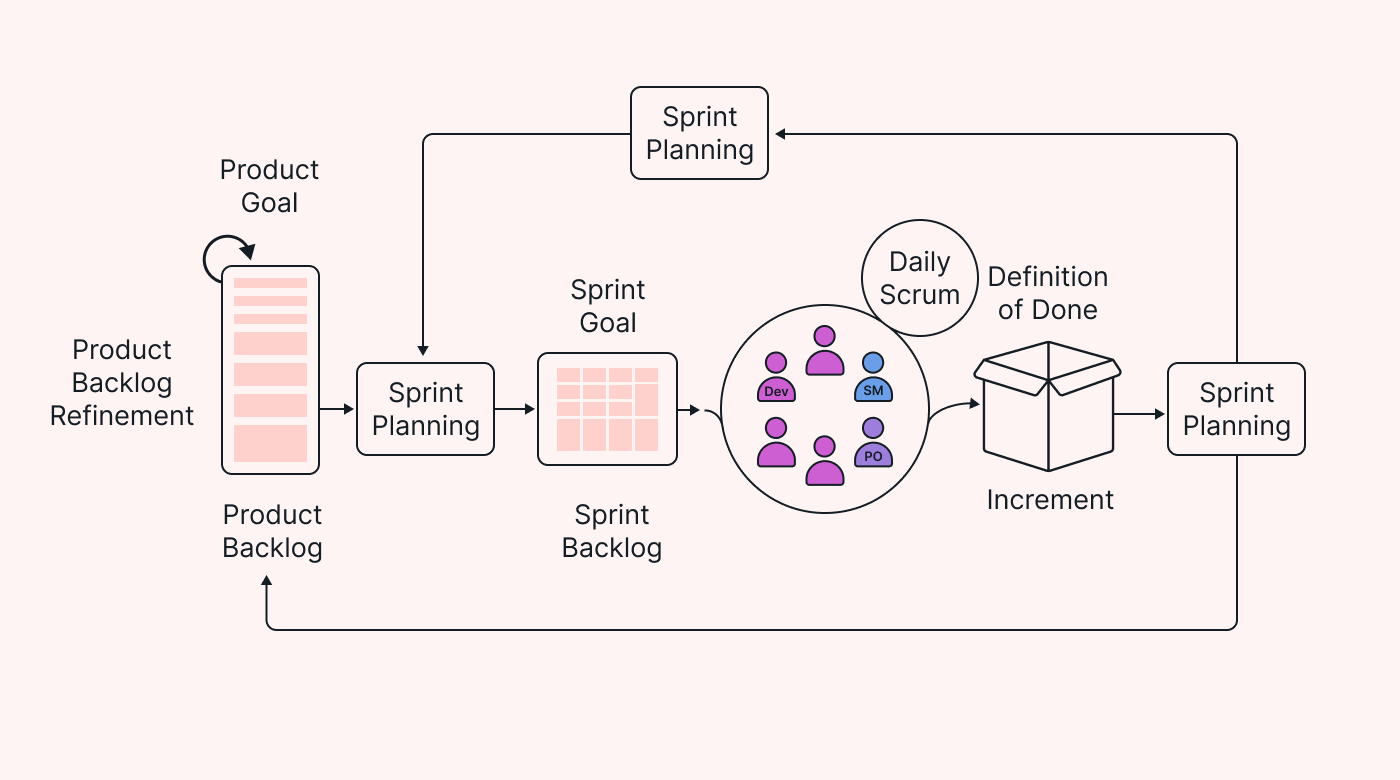 |
Scrum focuses on delivering increments of value using an iterative approach. It’s perfect for teams that want to move fast and must incorporate changes often.
The ideal size for a Scrum team is 5–11 people, allowing for the most significant degree of agility and adaptability.
What matters more than the size of the team is the ability of the team to manage themselves and work independently.
The Scrum framework is perfect for projects with high uncertainty in the early stages. It also works well for businesses in markets that move at breakneck speed and are constantly changing.
Examples include:
- Software agencies
- Online stores
- AI (recent addition)
Kanban
The Kanban framework uses visual cues to prioritize and plan work on physical or digital “boards.” Kanban is all about the flow of work, with work-in-progress (WIP) limits.
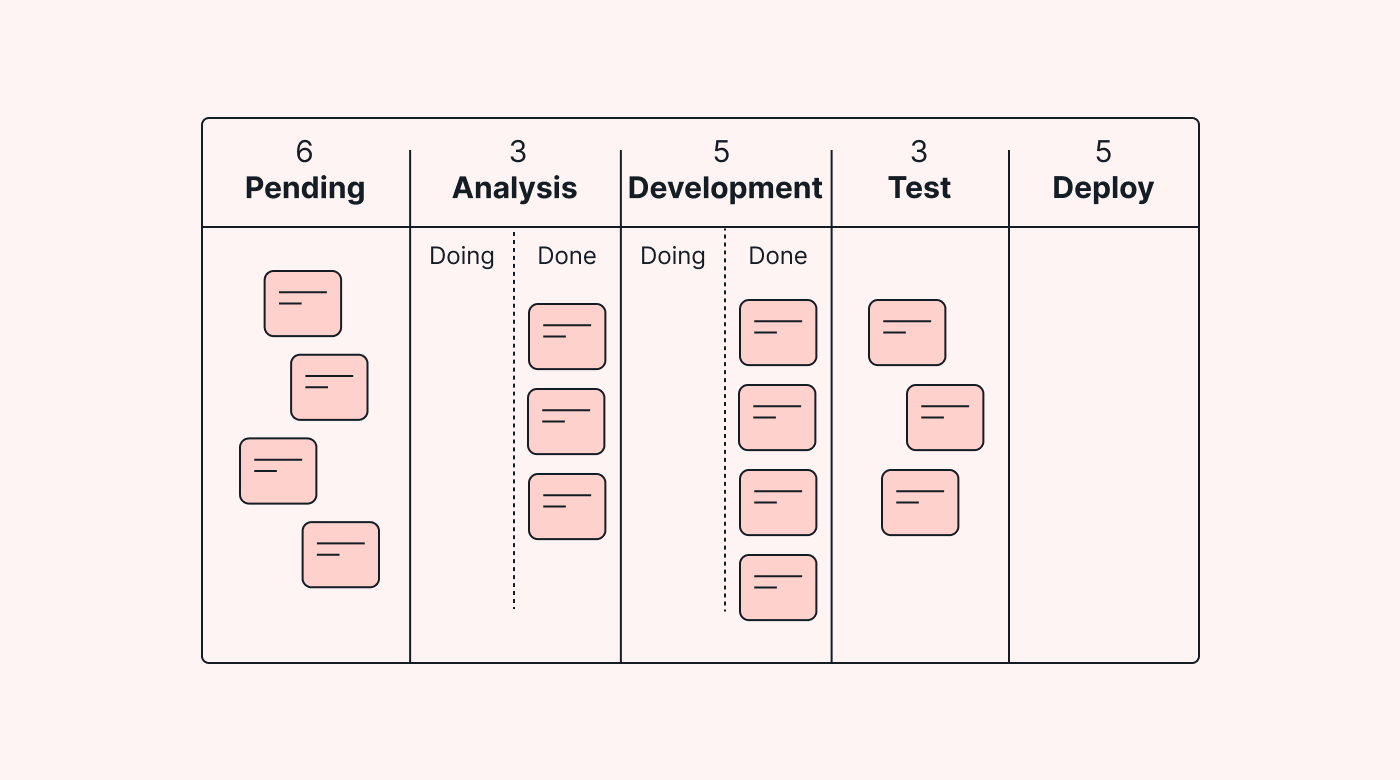 |
Kanban is among the most intuitive, straightforward, and highly effective frameworks.
The primary tool used in Kanban is the Kanban board mentioned earlier. Apart from the columns and “sticky notes” (or cards), the board can be split into horizontal swimlanes representing a particular workflow stage.
For example, a basic Kanban board consists of three columns (phases):
- To-Do
- Doing
- Done
However, you can add as many columns (or phases) as needed.
The cards (project tasks) move from left to right on the board.
The beauty of this popular framework is that it is based on “pulling” work into the next phase based on resources. These are the work-in-progress (WIP) limits for each column.
Kanban is a perfect framework for the (project management) uninitiated or fast-moving projects that need a simple system, like:
- Advertising
- Creative projects
- R&D
- Customer support teams
- Content agencies
- HR
- Educational institutions
Lean
Lean is based on three pillars:
- Delivering value as defined by the customer: here’s a simple way to remember this: the customer is always right. By the way, the customer can be internal (think stakeholders) or external (think paying customers).
- Eliminating waste: cutting unnecessary pieces of processes that don't add value.
- Continuous improvement: An ongoing feedback loop to help make progressive improvements to processes, products, and resources.
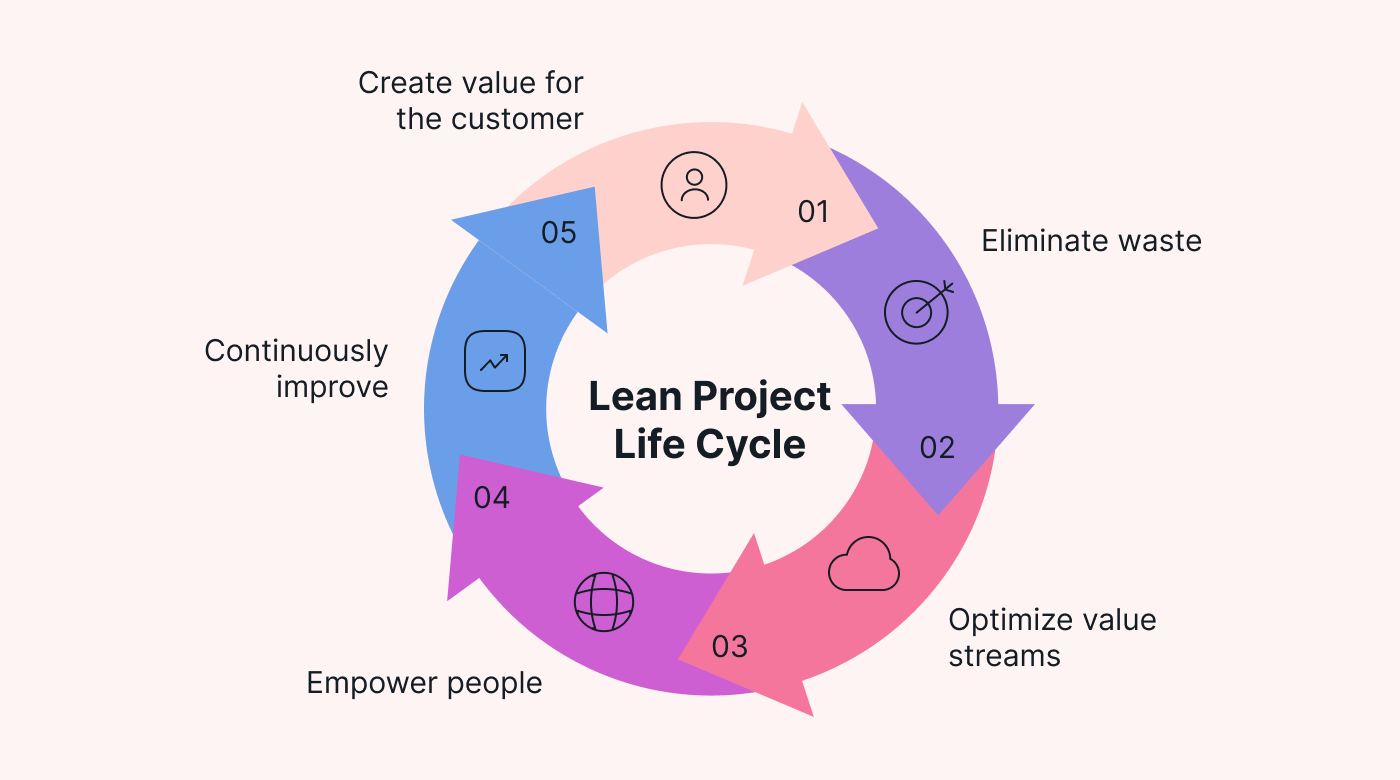 |
Cutting deeper, lean project management has five core principles:
1. Identify value
To deliver value to your customers, you must first understand their needs. Identifying value saves time and money by ensuring your team builds only features that add value for your customers.
2. Map the value stream
Value stream mapping uses diagrams to help visualize the project process, helping with value stream management, which is critical to eliminating waste.
3. Create a flow
A flow state is when you’re in a groove, and everything is going smoothly. Creating a flow state increases team engagement and performance when it comes to project work.
4. Establish pull
With a pull system, teams work on what they have the capacity for, not forecasted projections.
5. Seek perfection
Lean requires a growth mindset and strives for perfection through continuous improvement.
The Lean framework is perfect for:
- Start-ups
- Organizations with limited resources
- Businesses that want to improve efficiency
- Teams that produce uncertain products
Truth be told, these lean pillars can be applied to other frameworks to make them that much better. Speaking of which, you can use pieces of the different frameworks to make your own hybrid approach, like using Scrum ceremonies alongside a Kanban board and incorporating lean principles.
Tips to help you and your team implement project management frameworks
No matter the framework, boost performance (and outcomes) with these two tips:
Use project management software
Project management tools typically work with a variety of frameworks. For example, Motion uses a Kanban board template with all the features you need to implement the framework across your team.
Better yet, project management tools make task tracking and effective communication that much easier.
Use automation
Some tools like Motion use artificial intelligence (AI) to help automate common, time-consuming processes. For example, you can automate the task allocation process.
Or you can automate things like scheduling meetings and sending notifications.
For example, you can automatically notify your team that a task has been moved to the next stage or notify your stakeholders when milestones have been achieved.
Use Motion to support your project management framework
With the right framework, you stand a much better chance of getting your projects from idea to delivery.
Using Motion as a supplement to the framework you run with is like using concrete reinforcement for a building framework.
Motion makes it easy to start working with the framework of your choice.
Sign up for your 7-day free trial.

